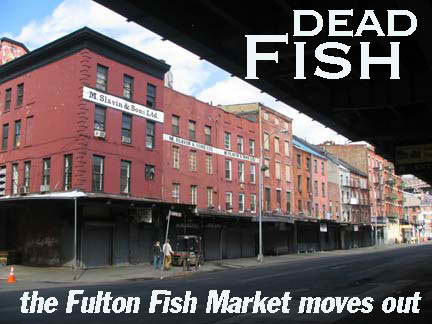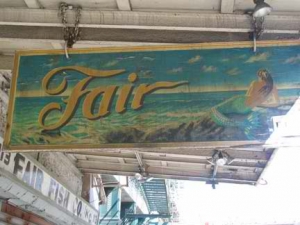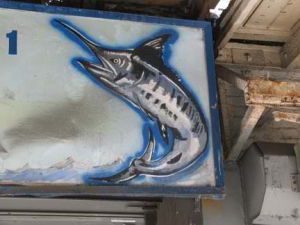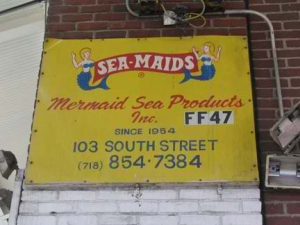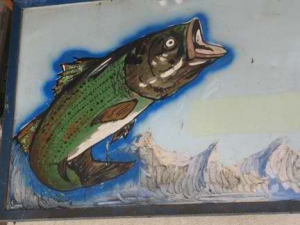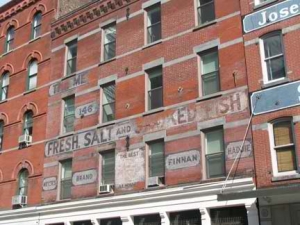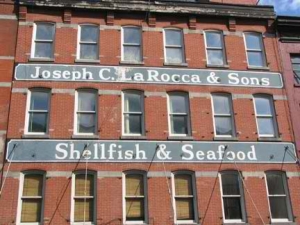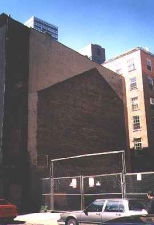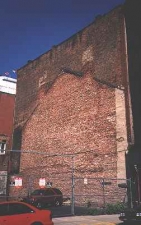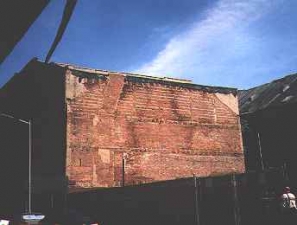YET another of New York City’s longstanding establishments is due for change in the imminent future; in July 2005 the Fulton Fish Market, in existence along either side of South Street in one form or another since 1835, was poised to relocate into a bigger, state of the art facility in Hunts Point, Bronx, joining the massive produce market already there.
Before that time, fishmongers had shared space with grocers, butchers and other businesses in the old Fulton Market Building between Beekman, Fulton, Front and South Streets, now replicated by a modern structure built in 1983. The fish wholesalers were voted out because water used to clean the fish was contaminating everything else there.
(TOP) 108-113 South Street buildings were built in 1818-1819.
Fish have not been unloaded directly from boats at the Fulton Fish Market for many years; the East River became too polluted for that. The fish is trucked in from locations all over the metropolitan area and retailers have gathered here every weeknight between midnight and between 6-9AM to make deals. Until the move to the Bronx, most of the Fish Market’s operations take place in the Tin Building on the east side of South Street at Pier 17. The Tin Building was built in 1995 to exactly match its 1907 predecessor building, which was lost in a suspicious fire.
I was never able to get up early enough to wander over to the Fish Market to see it in operation, and many out of towners who visit Pier 17 for overpriced souvenirs and ice cream never have an inkling about Fulton Street’s true industry. When visiting the Seaport, I could take in that not-completely-unpleasant fish smell and know that a part of old New York, the Fulton Fish Market, has been there for over 170 years and was still going strong. But with the move to the Bronx, it completes the Seaport’s long, drawn-out conversion to a combination museum and tourist mall. I’ll miss the fish smell…
But I’ll miss the handpainted, hand-lettered signs, too:
 Not sure if these signs will be taken along when the big move to the Bronx is made; in any case, the Hunts Point complex has a big gate and is closed to the public, so it’s doubtful they’ll be as visible as they are here on South Street.
Not sure if these signs will be taken along when the big move to the Bronx is made; in any case, the Hunts Point complex has a big gate and is closed to the public, so it’s doubtful they’ll be as visible as they are here on South Street.
146 and 148 Beekman Street offer two examples of painted ‘wall dog’ advertising, and ancient one (note “finnan haddie”, or smoked haddock) and a newer one. The buildings date from the 1880s and were designed by George Post. They have always been used for fish market-related businesses.
 211 Front, or 142 Beekman, was built in 1885 by Post and features cockleshell cornices, starfish-shaped end caps on its tie rods, and carved fish on its keystones. Tie rods were used to support load-bearing walls before steel framing became common in construction.
211 Front, or 142 Beekman, was built in 1885 by Post and features cockleshell cornices, starfish-shaped end caps on its tie rods, and carved fish on its keystones. Tie rods were used to support load-bearing walls before steel framing became common in construction.
 206 Front was likely built in 1798 or 1799 and was originally occupied by Matthew Howell, a grocer, and his family. Howell later became a gunpowder and military supplies dealer. The house was renovated in the early 1980s as part of the construction of the Seaport Museum. The Cannon family owned a wharf in the area in the early 1800s.
206 Front was likely built in 1798 or 1799 and was originally occupied by Matthew Howell, a grocer, and his family. Howell later became a gunpowder and military supplies dealer. The house was renovated in the early 1980s as part of the construction of the Seaport Museum. The Cannon family owned a wharf in the area in the early 1800s.
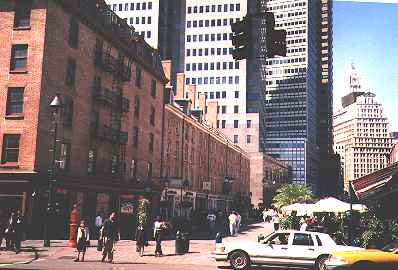 Peter Schermerhorn Jr. built this Georgian row of buildings on #2-18 Fulton between 1810 and 1812. He first had to fill in the land; Front Street, as its name implies, was the approximate original shoreline. The original Fulton Ferry, which ran between Manhattan and Brooklyn’s Fulton Streets, began to bring traffic beginning in 1814 and in that year, the first storefronts appeared on Schermerhorn Row. The mansard roof and dormer windows near South Street were added in the 1860s.
Peter Schermerhorn Jr. built this Georgian row of buildings on #2-18 Fulton between 1810 and 1812. He first had to fill in the land; Front Street, as its name implies, was the approximate original shoreline. The original Fulton Ferry, which ran between Manhattan and Brooklyn’s Fulton Streets, began to bring traffic beginning in 1814 and in that year, the first storefronts appeared on Schermerhorn Row. The mansard roof and dormer windows near South Street were added in the 1860s.
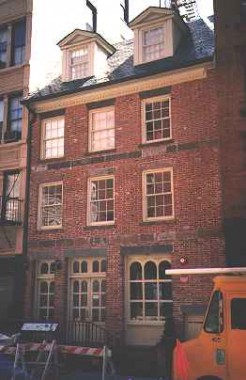 Captain Joseph Rose house, 273 Water Street between Peck Slip and Dover Street. When built between 1771 and 1783, NYC was still occupied by the British and the back door faced the East River. It was rebuilt in 1998.
Captain Joseph Rose house, 273 Water Street between Peck Slip and Dover Street. When built between 1771 and 1783, NYC was still occupied by the British and the back door faced the East River. It was rebuilt in 1998.
 259 Front Street was built for flour merchant David Leidig in about 1808. In 1830, he purchased flour mills near West Farms in the Bronx. Lydig Avenue in Morris Park is named for the family; David’s son Philip sold land to the city that became part of Bronx Park.
259 Front Street was built for flour merchant David Leidig in about 1808. In 1830, he purchased flour mills near West Farms in the Bronx. Lydig Avenue in Morris Park is named for the family; David’s son Philip sold land to the city that became part of Bronx Park.
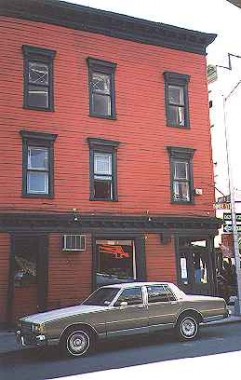 The Seaport district’s only wood-frame building is also home to NYC’s oldest bar. The house was built in 1794 and has housed a drinking or eating establishment on its ground floor since then: McCormick’s Bar, the Hole in the Wall, and others. See BAR SOME for more pics of the Bridge Cafe, the present establishment.
The Seaport district’s only wood-frame building is also home to NYC’s oldest bar. The house was built in 1794 and has housed a drinking or eating establishment on its ground floor since then: McCormick’s Bar, the Hole in the Wall, and others. See BAR SOME for more pics of the Bridge Cafe, the present establishment.
Many of the Seaport’s old 18th and 19th Century buildings have been torn down, many before they could collapse. But they have left their ghosts behind.
SOURCES:
Walking Around in South Street, Ellen Fletcher, South Street Seaport Museum 1999
BUY this book at Amazon.COM
Waterfront, Phillip Lopate, Crown Journeys 2004
BUY this book at Amazon.COM
Soon, a more comprehensive look at the ancient buildings of the Seaport will appear in Forgotten NY.
Photographed in 2000 and 2004. Page written 7/23/05.
erpietri”@”earthlink.net
©2005 Midnight Fish

